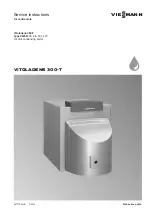
11
For normal cleaning, flush the heating surfaces thor-
oughly with water. For stubborn residues, surface
stains or soot deposits, cleaning agents can be used.
For this, observe the following:
■
Only use solvent-free cleaning agents. Ensure that
no cleaning agent gets between the boiler body and
the thermal insulation.
■
Remove soot deposits with alkaline agents contain-
ing surfactant additives (e.g. Fauch 400/410
*1
).
■
Combustion residues may create thin, yellow-brown
surface discolouration as well as hard deposits that
may only become visible after removing the soot
deposits. Discolouration on the surface of the stain-
less steel heat exchanger is a normal sign of use. It
has no bearing on the function or service life of the
heat exchanger. To remove hard deposits, use
slightly acidic, chloride-free cleaning agents based
on phosphoric acid (e.g. Antox 75 E
*1
).
■
Remove loose deposits from the heat exchanger and
flush the heating surface thoroughly with water.
Cleaning agent manufacturer's instructions
Checking gaskets and thermal insulation sections
1.
Check the gaskets and packing cords in the boiler
door for damage.
2.
Check the thermal insulation sections in the com-
bustion chamber and the boiler door for damage.
3.
Replace any damaged components.
Closing the boiler door
42.8/53.7 kW
Fig. 4
Note
Tighten the screws diagonally.
*1
Manufacturer: Hebro Chemie GmbH, Rostocker Strasse 40, D-41199 Mönchengladbach
Commissioning, inspection, maintenance
Cleaning the heating surface
(cont.)
5671704






































